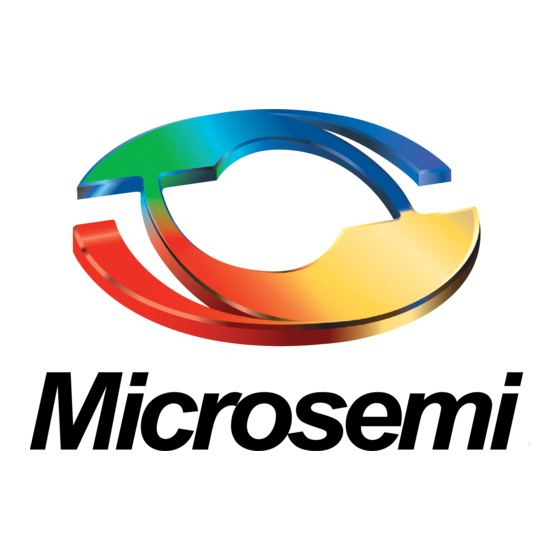

Microsemi SmartFusion2 MSS Manual
Usb configuration
Hide thumbs
Also See for SmartFusion2 MSS:
- User manual (829 pages) ,
- Demo manual (40 pages) ,
- Configuration manual (23 pages)
Table of Contents
Advertisement
Quick Links
Advertisement
Table of Contents

Summary of Contents for Microsemi SmartFusion2 MSS
- Page 1 SmartFusion2 MSS USB Configuration...
-
Page 2: Table Of Contents
SmartFusion2 MSS USB Configuration Table of Contents Introduction ..............3 1 Configuration Options. -
Page 3: Introduction
The functional behavior of each USB instance must be defined at the application level using the SmartFusion2 MSS USB Driver provided by Microsemi. In this document, we describe how you can configure the MSS USB instance and define how the peripheral signals are connected. -
Page 4: Configuration Options
1 – Configuration Options Interface Selection - Use this option to select between the ULPI and UTMI modes (Figure 1-1). When using the ULPI mode, all USB signals are connected to MSIOs. When using the UTMI option, all USB signals are connected the FPGA fabric. In either case, the 'Main Connection' column is not editable. ULPI Options - If you have selected the ULPI mode, you can: •... -
Page 5: Peripheral Signals Assignment Table
2 – Peripheral Signals Assignment Table The SmartFusion2 architecture provides a very flexible schema for connecting peripherals signals to either MSIOs or the FPGA fabric. Use the signal assignment configuration table to define what your peripheral is connected to in your application. This assignment table has the following columns: MSIO - Identifies the peripheral signal name configured in a given row. -
Page 6: Connectivity Preview
3 – Connectivity Preview The Connectivity Preview panel in the MSS USB Configurator dialog shows a graphical view of the current connections for the highlighted signal row (Figure 3-1). Figure 3-1 • I2C Connectivity Preview... -
Page 7: Resource Conflicts
4 – Resource Conflicts Because MSS peripherals (MMUART, I2C, SPI, CAN, GPIO, USB, Ethernet MAC) share MSIO and FPGA fabric access resources, the configuration of any of these peripherals may result in a resource conflict when you configure an instance of the current peripheral. Peripheral configurators provide clear indicators when such a conflict arises. -
Page 8: Error Example
Error Example The SPI_0 peripheral is used and uses the device PAD bounded to package pin Y30. Configuring the USB peripheral such that the DIR port is connected to an MSIO (ULPI, I/O Group A) results in an error. Figure 4-1 shows the error icon displayed in the connectivity assignment table for the DIR port. -
Page 9: Warning Example
Warning Example The GPIO peripheral is used and uses the device PAD bounded to package pin V24 (GPIO_3). Configuring the USB peripheral such that the DATA1 port is connected to an MSIO (ULPI, I/O Group A) results in a warning. Figure 4-3 shows the warning icon displayed in the connectivity assignment table for the DATA1 port. -
Page 10: Port Description
5 – Port Description Table 5-1 • ULPI Ports Port Name Port Group Direction Description ULPI_DIR USB_ULPI_PADS Signal controlling the direction of the data bus. The PHY should drive this signal High when it has data to be transferred. Otherwise, the PHY should drive this signal Low. - Page 11 Table 5-2 • UTMI Ports Port Name Port Group Direction Description UTMI_AVALID USB_UTMI_FABRIC VBus compared to session valid threshold for a B device (required to be between 0.8 V and 2 V) 1: Above the session valid threshold 0: Below the session valid threshold UTMI_SESEND USB_UTMI_FABRIC VBus compared to session end threshold (required to...
- Page 12 Table 5-2 • UTMI Ports Port Name Port Group Direction Description UTMI_DISCHRGVBUS USB_UTMI_FABRIC Discharge VBus (used by B devices to ensure that VBus is low enough before starting session request protocol (SRP)) UTMI_DPPULLDOWN USB_UTMI_FABRIC Enable for a pull-down resistor within the transceiver on the D+ line.
-
Page 13: A Product Support
Microsemi SoC Products Group staffs its Customer Technical Support Center with highly skilled engineers who can help answer your hardware, software, and design questions about Microsemi SoC Products. The Customer Technical Support Center spends a great deal of time creating application notes, answers to common design cycle questions, documentation of known issues, and various FAQs. -
Page 14: Itar Technical Support
My Cases Microsemi SoC Products Group customers may submit and track technical cases online by going to Cases. Outside the U.S. Customers needing assistance outside the US time zones can either contact technical support via email (soc_tech@microsemi.com) or contact a local sales office.







Need help?
Do you have a question about the SmartFusion2 MSS and is the answer not in the manual?
Questions and answers